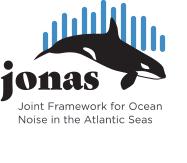 JONAS - Joint Framework for Ocean Noise in the Atlantic Seas
JONAS - Joint Framework for Ocean Noise in the Atlantic Seas JONAS - Joint Framework for Ocean Noise in the Atlantic Seas
JONAS - Joint Framework for Ocean Noise in the Atlantic SeasComments: download pdf
Ref.: JONAS Deliverable 5.3, February 2022
Executive summary:
Jonas will develop and pilot a noise-monitoring platform, harmonize technical approaches to MSFD
requirements, and promote the adoption of quieter operational practices among users of the NE
Atlantic marine space. This effort will essentially be based on extensive computer modeling using AIS and archival
environmental data to achieve the necessary coverage for the wide Atlantic area. Although the
collection of actual field data is not foreseen during the project itself, devising methods for
calibrating model output to better represent the reality is an absolute requirement. That is why work
package 5 deals with methodologies for computing noise maps and encompasses a task dedicated to
model calibration through ground truth acoustic measurements, under which this work was
performed. Ground truth calibration, here after "field calibration", represents a challenge for at least two main
reasons: one, is that the number of field observations are in all circumstances too few for efficiently
constrain the modeled field in large areas and during long periods of time, and second, there is no
known way to validate the calibrated field in a way to direct the calibration effort. In practice, there
is no well accepted methodology for field calibration and/or for data sampling strategy. Efforts in
that direction in previous EU projects such as BIAS and JOMOPANS provided data model comparisons but
no definite calibration strategies, entailing model modification to approach the observed data.
This report summarizes the work performed under the task dedicated to field calibration where the
problem is analyzed by describing previously proposed techniques and a number of possible future
approaches with their advantages and drawbacks are outlined. One of those approaches to our
knowledge, not previously tested on real data, was implemented in a data set kindly provided to
JONAS by the IMAR Okeanos group of the Azores University, with interesting results. Data - model
comparisons is then performed through objective distribution distance indicators and tested in
another data set gathered in the southwest approaches to the channel, off Bretagne.
Future developments will encompass the usage of this and other field calibration techniques for
computing broadband continuous noise and cetaceans impact indicators. Journal and conference
publications of this work are being submitted.